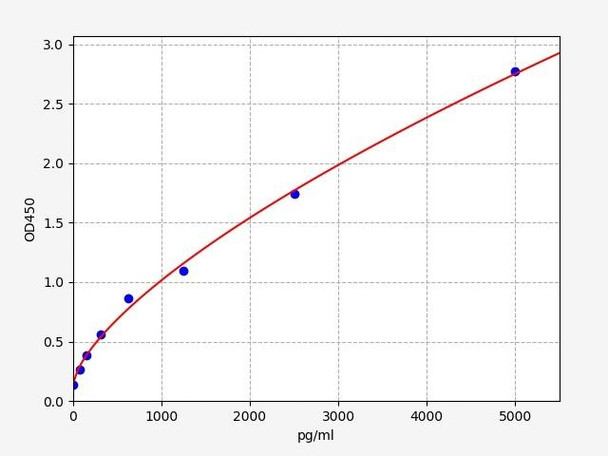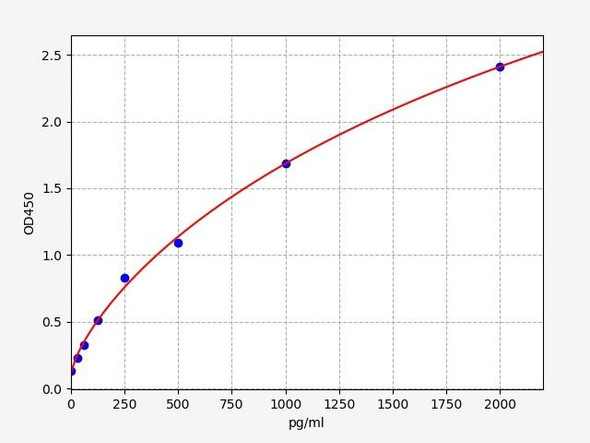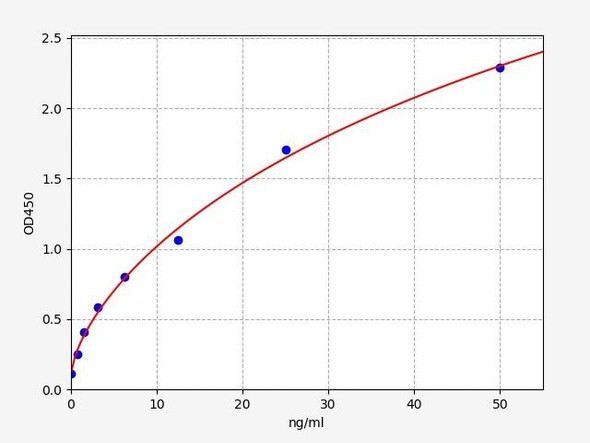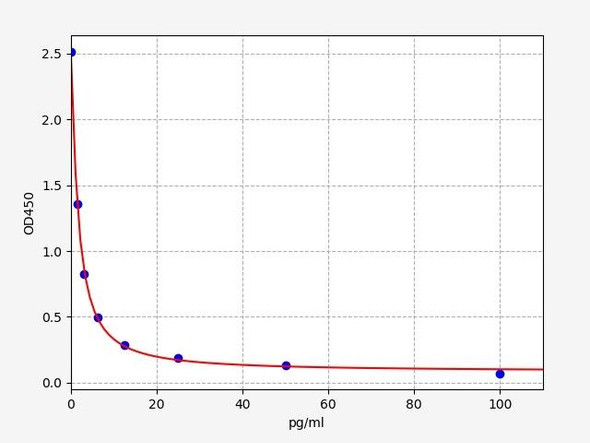Human IDH ELISA Kit
- SKU:
- HUFI01071
- Product Type:
- ELISA Kit
- Size:
- 96 Assays
- Uniprot:
- O75874
- Sensitivity:
- 46.875pg/ml
- Range:
- 78.125-5000pg/ml
- ELISA Type:
- Sandwich ELISA, Double Antibody
- Synonyms:
- IDH1, IsocitRate dehydrogenase [NADP] cytoplasmic, Oxalosuccinate decarboxylase, NADP, +-specific ICDH, IDH, Cytosolic NADP-isocitRate dehydrogenase, IDP, PICD, IDCD, IDPC
- Reactivity:
- Human
Description
Human IDH ELISA Kit
The oxidative decarboxylation of isocitrate to 2-oxoglutarate is catalysed by isocitrate dehydrogenases. These enzymes are divided into two groups, one that uses NAD(+) as an electron acceptor and the other that uses NADP(+). Three NAD(+)-dependent isocitrate dehydrogenases that localise to the mitochondrial matrix have been identified, as well as two NADP(+)-dependent isocitrate dehydrogenases, one of which is mitochondrial and the other predominantly cytosolic. Each isozyme that is dependent on NADP(+) is a homodimer. The NADP(+)-dependent isocitrate dehydrogenase found in the cytoplasm and peroxisomes is encoded by this gene. Metaphyseal Enchondromatosis With D-2-Hydroxyglutaric Aciduria and Glioma Susceptibility 1 are two diseases linked to IDH1. Amino Acid Metabolism and HIV Life Cycle are two related pathways.
| Product Name: | Human IDH ELISA Kit |
| Product Code: | HUFI01071 |
| Size: | 96 Assays |
| Alias: | IDH1, IsocitRate dehydrogenase [NADP] cytoplasmic, Oxalosuccinate decarboxylase, NADP, +-specific ICDH, IDH, Cytosolic NADP-isocitRate dehydrogenase, IDP, PICD, IDCD, IDPC |
| Detection method: | Sandwich ELISA, Double Antibody |
| Application: | This immunoassay kit allows for the in vitro quantitative determination of Human IDH1 concentrations in serum plasma and other biological fluids. |
| Sensitivity: | 46.875pg/ml |
| Range: | 78.125-5000pg/ml |
| Storage: | 4°C for 6 months |
| Note: | For Research Use Only |
| Recovery: | Matrices listed below were spiked with certain level of Human IDH1 and the recovery rates were calculated by comparing the measured value to the expected amount of Human IDH1 in samples. | ||||||||||||||||
| |||||||||||||||||
| Linearity: | The linearity of the kit was assayed by testing samples spiked with appropriate concentration of Human IDH1 and their serial dilutions. The results were demonstrated by the percentage of calculated concentration to the expected. | ||||||||||||||||
| |||||||||||||||||
| CV(%): | Intra-Assay: CV<8% Inter-Assay: CV<10% |
| Component | Quantity | Storage |
| ELISA Microplate (Dismountable) | 8×12 strips | 4°C for 6 months |
| Lyophilized Standard | 2 | 4°C/-20°C |
| Sample/Standard Dilution Buffer | 20ml | 4°C |
| Biotin-labeled Antibody(Concentrated) | 120ul | 4°C (Protect from light) |
| Antibody Dilution Buffer | 10ml | 4°C |
| HRP-Streptavidin Conjugate(SABC) | 120ul | 4°C (Protect from light) |
| SABC Dilution Buffer | 10ml | 4°C |
| TMB Substrate | 10ml | 4°C (Protect from light) |
| Stop Solution | 10ml | 4°C |
| Wash Buffer(25X) | 30ml | 4°C |
| Plate Sealer | 5 | - |
Other materials and equipment required:
- Microplate reader with 450 nm wavelength filter
- Multichannel Pipette, Pipette, microcentrifuge tubes and disposable pipette tips
- Incubator
- Deionized or distilled water
- Absorbent paper
- Buffer resevoir
| Uniprot | O75874 |
| UniProt Protein Function: | IDH1: an oxidoreductase that catalyzes the third step of the TCA cycle: the oxidative decarboxylation of isocitrate, consuming NADP(+), and producing alpha-ketoglutarate (alpha-KG) and CO2. Alpha-KG is an activator the dioxygenases that hydroxylate the transcription factor HIF and lead to its degradation by VHL. Since HIF turns on oncogenic pathways, IDH1 has apparent tumor suppressor activity. Homo-dimerization is required for activity. Each subunit binds 1 magnesium or manganese ion. IDH1 is located in the cytosol and peroxisomes. Somatic mutations affecting arginine 132 (R132) are found in 80% of grade II?III gliomas and secondary glioblastomas in humans, and cause disease in a tissue-specific fashion. Only a single copy of the gene has been found to be mutated in tumours. Mutations of R132 to H, C, S, G, V, or L have been reported to be neomorphic, abolishing the conversion of isocitrate to alpha-KG. Instead, alpha-KG is converted to R(-)-2-hydroxyglutarate (2HG). Elevated levels of 2HG correlate with an elevated risk of malignant brain tumors. Neomorphic mutations in IDH1 and IDH2 convert alpha-KG to 2-hydroxyglutarate (2-HG) occur in a high percentage of patients with cytogenetically normal acute myeloid leukemia (AML). |
| UniProt Protein Details: | Protein type:Carbohydrate Metabolism - citrate (TCA) cycle; EC 1.1.1.42; Other Amino Acids Metabolism - glutathione; Oxidoreductase Chromosomal Location of Human Ortholog: 2q34 Cellular Component: cell-cell adherens junction; cytoplasm; cytosol; peroxisomal matrix; peroxisome Molecular Function:(R)-2-hydroxyglutarate dehydrogenase activity; isocitrate dehydrogenase (NADP+) activity; magnesium ion binding; protein homodimerization activity; receptor binding Biological Process: 2-oxoglutarate metabolic process; isocitrate metabolic process; NADPH regeneration Disease: Glioma Susceptibility 1 |
| NCBI Summary: | Isocitrate dehydrogenases catalyze the oxidative decarboxylation of isocitrate to 2-oxoglutarate. These enzymes belong to two distinct subclasses, one of which utilizes NAD(+) as the electron acceptor and the other NADP(+). Five isocitrate dehydrogenases have been reported: three NAD(+)-dependent isocitrate dehydrogenases, which localize to the mitochondrial matrix, and two NADP(+)-dependent isocitrate dehydrogenases, one of which is mitochondrial and the other predominantly cytosolic. Each NADP(+)-dependent isozyme is a homodimer. The protein encoded by this gene is the NADP(+)-dependent isocitrate dehydrogenase found in the cytoplasm and peroxisomes. It contains the PTS-1 peroxisomal targeting signal sequence. The presence of this enzyme in peroxisomes suggests roles in the regeneration of NADPH for intraperoxisomal reductions, such as the conversion of 2, 4-dienoyl-CoAs to 3-enoyl-CoAs, as well as in peroxisomal reactions that consume 2-oxoglutarate, namely the alpha-hydroxylation of phytanic acid. The cytoplasmic enzyme serves a significant role in cytoplasmic NADPH production. Alternatively spliced transcript variants encoding the same protein have been found for this gene. [provided by RefSeq, Sep 2013] |
| UniProt Code: | O75874 |
| NCBI GenInfo Identifier: | 21903432 |
| NCBI Gene ID: | 3417 |
| NCBI Accession: | O75874.2 |
| UniProt Secondary Accession: | O75874,Q567U4, Q6FHQ6, Q7Z3V0, Q93090, Q9NTJ9, Q9UKW8 |
| UniProt Related Accession: | O75874 |
| Molecular Weight: | 46,659 Da |
| NCBI Full Name: | Isocitrate dehydrogenase |
| NCBI Synonym Full Names: | isocitrate dehydrogenase (NADP(+)) 1, cytosolic |
| NCBI Official Symbol: | IDH1 |
| NCBI Official Synonym Symbols: | IDH; IDP; IDCD; IDPC; PICD; HEL-216; HEL-S-26 |
| NCBI Protein Information: | isocitrate dehydrogenase [NADP] cytoplasmic |
| UniProt Protein Name: | Isocitrate dehydrogenase [NADP] cytoplasmic |
| UniProt Synonym Protein Names: | Cytosolic NADP-isocitrate dehydrogenase; IDP; NADP(+)-specific ICDH; Oxalosuccinate decarboxylase |
| Protein Family: | Isocitrate dehydrogenase |
| UniProt Gene Name: | IDH1 |
*Note: Protocols are specific to each batch/lot. For the correct instructions please follow the protocol included in your kit.
Before adding to wells, equilibrate the SABC working solution and TMB substrate for at least 30 min at 37°C. When diluting samples and reagents, they must be mixed completely and evenly. It is recommended to plot a standard curve for each test.
| Step | Protocol |
| 1. | Set standard, test sample and control (zero) wells on the pre-coated plate respectively, and then, record their positions. It is recommended to measure each standard and sample in duplicate. Wash plate 2 times before adding standard, sample and control (zero) wells! |
| 2. | Aliquot 0.1ml standard solutions into the standard wells. |
| 3. | Add 0.1 ml of Sample / Standard dilution buffer into the control (zero) well. |
| 4. | Add 0.1 ml of properly diluted sample ( Human serum, plasma, tissue homogenates and other biological fluids.) into test sample wells. |
| 5. | Seal the plate with a cover and incubate at 37 °C for 90 min. |
| 6. | Remove the cover and discard the plate content, clap the plate on the absorbent filter papers or other absorbent material. Do NOT let the wells completely dry at any time. Wash plate X2. |
| 7. | Add 0.1 ml of Biotin- detection antibody working solution into the above wells (standard, test sample & zero wells). Add the solution at the bottom of each well without touching the side wall. |
| 8. | Seal the plate with a cover and incubate at 37°C for 60 min. |
| 9. | Remove the cover, and wash plate 3 times with Wash buffer. Let wash buffer rest in wells for 1 min between each wash. |
| 10. | Add 0.1 ml of SABC working solution into each well, cover the plate and incubate at 37°C for 30 min. |
| 11. | Remove the cover and wash plate 5 times with Wash buffer, and each time let the wash buffer stay in the wells for 1-2 min. |
| 12. | Add 90 µl of TMB substrate into each well, cover the plate and incubate at 37°C in dark within 10-20 min. (Note: This incubation time is for reference use only, the optimal time should be determined by end user.) And the shades of blue can be seen in the first 3-4 wells (with most concentrated standard solutions), the other wells show no obvious color. |
| 13. | Add 50 µl of Stop solution into each well and mix thoroughly. The color changes into yellow immediately. |
| 14. | Read the O.D. absorbance at 450 nm in a microplate reader immediately after adding the stop solution. |
When carrying out an ELISA assay it is important to prepare your samples in order to achieve the best possible results. Below we have a list of procedures for the preparation of samples for different sample types.
| Sample Type | Protocol |
| Serum | If using serum separator tubes, allow samples to clot for 30 minutes at room temperature. Centrifuge for 10 minutes at 1,000x g. Collect the serum fraction and assay promptly or aliquot and store the samples at -80°C. Avoid multiple freeze-thaw cycles. If serum separator tubes are not being used, allow samples to clot overnight at 2-8°C. Centrifuge for 10 minutes at 1,000x g. Remove serum and assay promptly or aliquot and store the samples at -80°C. Avoid multiple freeze-thaw cycles. |
| Plasma | Collect plasma using EDTA or heparin as an anticoagulant. Centrifuge samples at 4°C for 15 mins at 1000 × g within 30 mins of collection. Collect the plasma fraction and assay promptly or aliquot and store the samples at -80°C. Avoid multiple freeze-thaw cycles. Note: Over haemolysed samples are not suitable for use with this kit. |
| Urine & Cerebrospinal Fluid | Collect the urine (mid-stream) in a sterile container, centrifuge for 20 mins at 2000-3000 rpm. Remove supernatant and assay immediately. If any precipitation is detected, repeat the centrifugation step. A similar protocol can be used for cerebrospinal fluid. |
| Cell culture supernatant | Collect the cell culture media by pipette, followed by centrifugation at 4°C for 20 mins at 1500 rpm. Collect the clear supernatant and assay immediately. |
| Cell lysates | Solubilize cells in lysis buffer and allow to sit on ice for 30 minutes. Centrifuge tubes at 14,000 x g for 5 minutes to remove insoluble material. Aliquot the supernatant into a new tube and discard the remaining whole cell extract. Quantify total protein concentration using a total protein assay. Assay immediately or aliquot and store at ≤ -20 °C. |
| Tissue homogenates | The preparation of tissue homogenates will vary depending upon tissue type. Rinse tissue with 1X PBS to remove excess blood & homogenize in 20ml of 1X PBS (including protease inhibitors) and store overnight at ≤ -20°C. Two freeze-thaw cycles are required to break the cell membranes. To further disrupt the cell membranes you can sonicate the samples. Centrifuge homogenates for 5 mins at 5000xg. Remove the supernatant and assay immediately or aliquot and store at -20°C or -80°C. |
| Tissue lysates | Rinse tissue with PBS, cut into 1-2 mm pieces, and homogenize with a tissue homogenizer in PBS. Add an equal volume of RIPA buffer containing protease inhibitors and lyse tissues at room temperature for 30 minutes with gentle agitation. Centrifuge to remove debris. Quantify total protein concentration using a total protein assay. Assay immediately or aliquot and store at ≤ -20 °C. |
| Breast Milk | Collect milk samples and centrifuge at 10,000 x g for 60 min at 4°C. Aliquot the supernatant and assay. For long term use, store samples at -80°C. Minimize freeze/thaw cycles. |



![Human Isocitrate dehydrogenase [NADP], mitochondrial (IDH2) ELISA Kit Human Isocitrate dehydrogenase [NADP], mitochondrial (IDH2) ELISA Kit](https://cdn11.bigcommerce.com/s-39x6lpnvxv/images/stencil/590x590/products/113206/111390/human-isocitrate-dehydrogenase-nadp-mitochondrial-idh2-elisa-kit__58855__96376.1647949402.jpg?c=1)
![Human Isocitrate dehydrogenase [NADP] cytoplasmic (IDH1) ELISA Kit Human Isocitrate dehydrogenase [NADP] cytoplasmic (IDH1) ELISA Kit](https://cdn11.bigcommerce.com/s-39x6lpnvxv/images/stencil/590x590/products/112917/111101/human-isocitrate-dehydrogenase-nadp-cytoplasmic-idh1-elisa-kit__43411__66734.1647949354.jpg?c=1)



